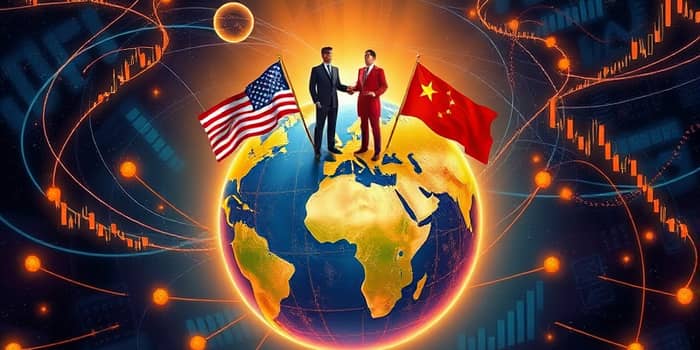
In early 2025, a dramatic escalation of trade and tariff measures between the world’s two largest economies has injected fresh uncertainty into global markets. Investors, policymakers, and businesses are assessing how renewed friction between the United States and China will shape growth prospects, supply chains, and financial sentiment worldwide.
This article unpacks the recent policy moves, quantifies their economic impact, examines market reactions, and explores the deeper drivers behind continuing disputes. By understanding these dynamics, readers can better anticipate risks and opportunities as the standoff unfolds.
At the start of 2025, the United States announced a sweeping package of tariff increases targeting imports from China and other key trading partners. In a surprise move, Washington briefly raised tariffs to 145% on sensitive goods, only to negotiate a rollback to a 30% rate by mid-year under a limited trade agreement. Beijing responded in kind, initially imposing duties up to 125% on American exports before easing its rates to 10% as part of the same deal.
Despite this temporary de-escalation, the cycle of threats and concessions has sown lingering doubt. China has maintained its official 2025 growth target of 5%, signaling confidence in domestic resilience even as external demand weakens. In contrast, the U.S. outlook has improved modestly: forecasts now project 0.6% year-on-year GDP growth in Q4 of 2025, compared to 0.2% before the deal, and global recession probability has dipped below 50%.
The tariff surge and ensuing retaliation have significantly disrupted international trade flows. In May 2025, U.S. seaborne imports from China plunged by a staggering 28.5% year-on-year—the largest decline since the height of the pandemic. Key West Coast ports bore the brunt of the downturn: Long Beach volumes fell 31.6%, while Los Angeles experienced a 29.9% slide in China-origin goods.
On a macro scale, economists estimate that a uniform 10% U.S. tariff, combined with a 110% levy on Chinese goods, could shave off 1% of global GDP. When risk-off sentiment is factored in, that drag might double. Reflecting these headwinds, the World Bank has trimmed its 2025 global growth forecast to 2.3%, the weakest non-recession projection since 2008.
Financial markets have oscillated between hope and anxiety as traders digest each round of trade rhetoric. JPMorgan Research describes U.S. equity markets as likely to remain range-bound amid ongoing uncertainty, setting a baseline S&P 500 target of 5,200. Only a clear breakthrough in negotiations would lift investor confidence substantially.
Meanwhile, the U.S. dollar hit a three-year low in June 2025, reacting to the unpredictability of tariff announcements and their potential to undermine growth. Emerging-market currencies have also come under pressure as capital flows shift toward perceived safe havens.
Beyond headline tariffs, a complex web of strategic disputes underpins bilateral tensions. The U.S. has long criticized China’s state subsidies for industrial champions, arguing they distort global competition and disadvantage foreign firms. Allegations of currency manipulation persist, with Washington pointing to historical interventions designed to keep the yuan weak and exports competitive.
In response to mounting external pressures, Beijing unveiled a mix of monetary and fiscal stimulus aimed at shoring up domestic demand. Early proposals included issuing 1 trillion yuan extra bonds—about 0.7% of GDP—to finance infrastructure and consumption incentives, though the final package was scaled back after the mid-year trade concessions.
Washington, meanwhile, has signaled that the 2025 trade deal represents only a temporary reprieve. Senior officials continue to hint at new tariffs if access to critical technology sectors and protections for intellectual property are not strengthened. This unpredictability keeps global risk aversion elevated.
One clear outcome of the U.S.-China tensions has been accelerated efforts by multinationals to diversify supply chains. Regions such as Vietnam, India, and Mexico have captured new investment as firms seek alternatives to Chinese manufacturing hubs. However, shifting production is costly and time-consuming, meaning disruptions will persist for years.
Persistent fears of a wider “decoupling” between the U.S. and Chinese economies risk deepening global fragmentation. Long-term cooperation on technology standards, climate change, and public health could be sidelined by competitive nationalism. As a result, persistent risk-off sentiment globally may crystallize into structural headwinds for trade and innovation.
For investors and corporate leaders, the path forward requires scenario planning and agility. Supply chain resilience can be enhanced through diversified sourcing, strategic inventory buffers, and digital monitoring of trade flows. Policymakers, meanwhile, must balance domestic political pressures with the need to stabilize an interconnected global economy.
In the coming months, every new tariff announcement, negotiation round, or economic data release will test the resolve of markets and authorities alike. While complete resolution remains elusive, understanding the interplay of policy, economics, and sentiment is the first step toward navigating an era of sustained geopolitical risk.
References













